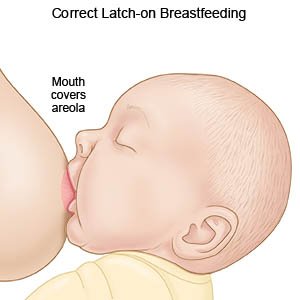Breastfeeding and Nipple Soreness
Medically reviewed by Drugs.com. Last updated on Apr 6, 2025.
What do I need to know about nipple soreness?
You may have sore or tender nipples when you start to breastfeed. Nipple soreness is usually caused by incorrect latch and positioning. After you have found a position that works and your baby has a good latch, breastfeeding should be comfortable. You should not have pain, blisters, or bruises when you breastfeed. Your nipples should not crack, scab, or bleed. Engorgement may also cause nipple soreness.
What can I do to manage nipple soreness?
- Apply a few drops of breast milk to your nipples. Breast milk is naturally soothing. Do not wear bras or clothes that are tight and put pressure on your nipples.
- Wash your nipples with warm water only. Do not use soaps that contain alcohol or other chemicals. These can dry and irritate your nipples. Do not use nursing pads that are lined with plastic. Let your nipples air dry after you bathe or breastfeed. Wear loose, soft cotton shirts.
- Ask your healthcare provider about the best cream or ointment for you. Change nursing pads often to keep moisture away from your nipples. Ask about medicines to help decrease pain and swelling.
What can I do to prevent nipple soreness?
- Help your baby get a good latch. Gently break suction and reposition if your baby is only sucking on the nipple. Talk to a lactation consultant if you need help with your baby's latch. Offer your baby the nipple that is less sore first. Your baby's suction is usually harder when he or she first starts breastfeeding. Breastfeed 8 to 12 times each day. Frequent breastfeeding can help decrease nipple soreness and prevent engorgement.

- Breastfeed or pump every 2 or 3 hours. Frequent breastfeeding helps decrease nipple soreness from engorgement. Express or pump milk from your breasts before you breastfeed. This will help soften your breast and your nipple, and allow your baby to latch on better.
- Change positions each time you breastfeed. This may help to keep pressure off of sore areas.
- Use a breast pump if it is too painful to breastfeed until your nipples heal.
Further information
- American Academy of Pediatrics
345 Park Boulevard
Itasca , IL 60143
Phone: 1- 800 - 433-9016
Web Address: http://www.aap.org
- La Leche League International
957 North Plum Grove Road
Schaumburg , IL 60173
Phone: 1- 847 - 519-7730
Phone: 1- 800 - 525-3243
Web Address: http://www.lalecheleague.org
When should I seek immediate care?
- One or both of your breasts is red, swollen or hard, painful, and feels warm or hot.
- Your nipple has pus coming out of it.
When should I contact my healthcare provider?
- You have a fever.
- Your nipple is red, dry, cracked, bleeding, or they have scabs on them.
- You see or feel a tender lump in your breast.
- You have questions or concerns about your condition or care.
Care Agreement
You have the right to help plan your care. Learn about your health condition and how it may be treated. Discuss treatment options with your healthcare providers to decide what care you want to receive. You always have the right to refuse treatment. The above information is an educational aid only. It is not intended as medical advice for individual conditions or treatments. Talk to your doctor, nurse or pharmacist before following any medical regimen to see if it is safe and effective for you.© Copyright Merative 2025 Information is for End User's use only and may not be sold, redistributed or otherwise used for commercial purposes.
Learn more about Breastfeeding and Nipple Soreness
Treatment options
Always consult your healthcare provider to ensure the information displayed on this page applies to your personal circumstances.
